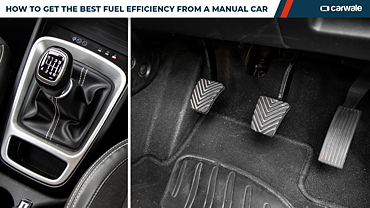
The Mahindra TUV300 is the first big ticket launch in the sub-four metre compact SUV segment, after the Ford EcoSport. The two SUVs use completely different approaches to cater to the same segment; the Ford EcoSport is an extension of a hatchback platform, while the TUV300 is a downsized old-school SUV.
We compare the Mahindra TUV300 and Ford EcoSport on paper to find out which one of them has the upper hand.

Mahindra has opted for the old-school styling for the new compact SUV. The TUV300 has a rather boxy shape with sharp edges that give it the SUV feel. The front of the car gets a vertical slat grille which is heavily influenced by the Grand Cherokee Jeep. The front bumper has a huge rectangular air dam, the fog lamp housings have a similar shape and even the headlamps have straight lines to match the front.
Where the front of the Mahindra TUV300 looks dramatic, the side profile is understated with very simple lines. The blacked-out B-pillar and the black roof rails are the only other noticeable aspects from this angle, apart from the 10-spoke alloy wheels. The rear profile reminds us of the Quanto with the black pillar and vertical tail lamp unit. The spare wheel is mounted on the rear door to add some bulk to the car.
The Ford EcoSport follows the Kinetic design philosophy that the company has been putting onto showroom floors for a few years now. It is also markedly aggressive, with the wheel pushed out at the corners, and from the front they are emphatically the widest point of the car thanks to the flared wheel arches. The lower grille dominates the front, looking like a basking shark from some angles with its concave surface and chrome ribs. The headlamps remain slits on either side of a truly narrow upper grille, in the middle of which sits a tiny blue oval.
From the side, the EcoSport has a typical SUV silhouette with a few marked exceptions: the rear overhang is comically short, courtesy the sub-four metre size. The rear is dominated by the spare wheel, and on either side of the wheel are the tail lamps, as always. The tail lamps are one of the best-designed features of the EcoSport, the tailgate handle is also smartly integrated into them.
In terms of looks, we think the Ford EcoSport wins. The TUV300 does look masculine, but the EcoSport design is so much more modern and in line with the market trend.


The TUV300 interior is a huge step over the previous Mahindra cars. The look and feel is much better and the quality is also significantly improved. The TUV300 gets dual tone beige and black treatment that makes the cabin look roomy. The music system with tiny screen and the AC vents sit inside a hexagonal unit with silver surrounds. There are bottle holders at the front and back, but the utility it has to offer is not comparable with the EcoSport.
With the boxy design, Mahindra has managed to maximise the cabin space. There is plenty of knee room and headroom for the second row passengers, a big plus over most of the sub-four metre cars. Speaking about plus points, Mahindra has added two jump seats at the back making it a seven-seater. Though these seats can accommodate only children, the 384litre boot capacity is respectable. The features list on this compact SUV is also decent.The car gets a music system with Bluetooth audio and telephony, rear parking assistance, climate control and passive cornering headlamps.
The EcoSport gets a typical Ford interior with a flowing layout and all-black treatment. The fit and finish is top-class. The centre console gets silver treatment, an angular music system interface and AC vents. Ford has really worked on the utility as there are plenty of cup and bottle holders both at the front and back. The features list on the top-end includes music system with Microsoft Sync, rear parking sensors and climate control.
In terms of cabin space, the EcoSport is not the best option for the rear seat passengers. It is little cramped for three to sit abreast and the leg room also not that great. The boot space at 340 litres is not the biggest in the segment, considering the fact that compact sedans and even the hatchbacks like Honda Jazz offer more.
Both the cars get ABS-EBD and top-airbags as part of the safety net, the only addition to the EcoSport is the Sync system that dials to the emergency services in case of an incident. The TUV300 wins in terms of the cabin and boot space. Even the quality of the TUV300 is pretty good even if it is not on par with Ford.


Mahindra is offering the TUV300 only with the diesel engine option, the compact SUV uses the same engine from the Quanto. The TUV uses the 1.5-litre three-cylinder diesel engine producing 84bhp and 81bhp in the manual and AMT versions respectively. With the two-stage turbocharger, it delivers decent 230Nm of torque at 1,500rpm. The engine powers the rear wheels via either the five-speed manual or five-speed AMT gearbox making it the first compact-SUV to have the convenience of an auto transmission. The car comes with Eco mode and Mahindra claims an ARAI efficiency of 18.49kmpl.
The Ford EcoSport is available with both the petrol and diesel engine options. The petrol models use either the 1.5-litre four-cylinder unit developing 109bhp and 140Nm of torque or the 1.0-litre three-cylinder EcoBoost producing 123bhp and 170Nm. The 1.5-litre engine can be availed with the six-speed dual-clutch transmission, while the five-speed gearbox is standard across the range. The diesel variants are powered by the 1.5-litre TDCi engine tuned to produce 89bhp and 204Nm of torque.
While on paper the power figures of the EcoSport and the TUV300 look pretty similar, the Ford has an advantage with much lower kerb weight that significantly affects the performance. The ARAI efficiency of the diesel EcoSport is also higher than the TUV300 at 22.7kmpl.


We think the Ford EcoSport is a better looking car of the two, though the Mahindra TUV300 has a more SUVish appeal. The TUV300 wins in terms of cabin space and added utility with the seven-seat configuration, though Ford quality is superior.
The Ford EcoSport also has more engine options, better performance and fuel efficiency, especially since the ladder-on-frame architecture of the TUV300 makes it very heavy. However, the biggest advantage of the TUV300 is the pricing – the base model priced at Rs 6.90 lakh is almost a lakh cheaper than the EcoSport, at the top-end the difference is close to Rs 1.75 lakh. Moreover, the TUV300 is the only diesel automatic compact SUV on sale in India.






